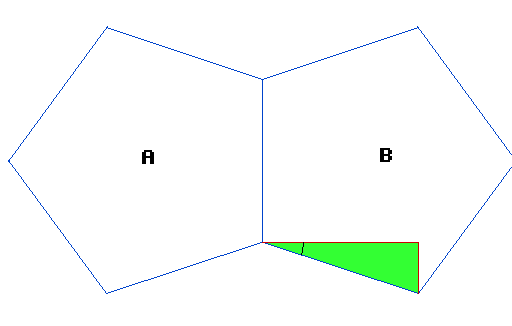 Angle Between Dodecahedron Faces
Angle Between Dodecahedron Faces Angle Between Dodecahedron Faces
Angle Between Dodecahedron FacesPurpose
Many game programs need spherical worlds. How can a grid be put on a spherical world? The HexGridIcosahedron is one solution.
In order to calculate the errors inherent in the HexGridIcosahedron, we need to know the arc-length of each edge of the icosahedron. This arc-length equals the AngleBetweenDodecahedronFaces.
The CrossProductExample page solves this problem using CrossProducts. That solution is long and complex. A simpler solution is given below.
The Left Pentagon -- A
Let's set up a temporary coordinate system (for this page only), just for finding the arc-length of an icosahedron edge. Let s = length of a dodecahedron edge. Place 3 corners of a pentagon COAED at: (xC=0, yC=s, zC=0) (xO=0, yO=0, zO=0) (xA=-s*cos(18°), yA=-s*sin(18°), zA=0) These 3 points are on the left pentagon in the illustration below.The Right Pentagon -- B (when flat)
Place 3 corners of a pentagon OCFGB at: (xC=0, yC=s, zC=0) (xO=0, yO=0, zO=0) (xB= s*cos(18°), yB=-s*sin(18°), zB=0) (When flat on table) These 3 points are on the right pentagon in the illustration below, when it starts out flat on the table.The Right Pentagon -- B (when rotated into place)
Rotate the right pentagon about the y-axis (edge OC), until the top view of angle COB bisects angle COA. (It has to, because there is a similar pentagon touching OA that is being rotated up the same amount, so that all three pentagons touch each other.) These 3 corners of OCFGB are now at: (xC=0, yC=s, zC=0) (xO=0, yO=0, zO=0) (xB= s*cos(18°)*cos(crow), yB=-s*sin(18°), zB=s*cos(18°)*sin(crow)) (In 3-D)The solution
Where crow = elevation of pentagon OCFGB above the x-y plane
= angle between faces of the dodecahedron
measured at the center of the dodecahedron
= arc-length of an edge of an icosahedron
measured along the surface of a unit sphere.
Because the top view of angle COB bisects angle COA,
tan(-36°) = (yB - yO) / (xB - xO)
= -s*sin(18°) / (s*cos(18°)*cos(crow))
tan( 36°) = sin(18°) / cos(18°)/cos(crow)
= tan(18°) / cos(crow)
cos(crow) = tan(18°) / tan(36°)
crow = arccos(tan(18°)/tan(36°))
~ 63.435°
~ 1.10715 rad
The CrossProductExample also illustrates how general techniques can give exceedingly long and complex calculations, whereas a little thought can reduce the calculation required to almost zero.

Imagine pentagon A is flat on the table. The marked angle in the green triangle is clearly 18 degrees. As you fold up pentagon B that angle (in vertical projection) will increase. You need to make it 36 degrees, and a small amount of trigonometry shows that it is accomplished when the angle made with the table is arccos(tan(18°)/tan(36°)), as above.
A colleague has just commented that this solution is less "worked out" than the CrossProductExample, so I drew two diagrams and he said "Hmm, it is obvious, isn't it."
Another fairly short solution involves inscribing a cube in the dodecahedron. This solution is exact, and should match the answer above.
This solution gives
crow = 180° - arcsin(sin(54°)/cos(18°))
~ 63.435°
This angle is arctan(2). Is there a simple construction which leads directly to arctan(2)? -- vk
See also: CrossProductExample, HexGridIcosahedron, GeographyExample, SphericalTrigonometry
 EditText of this page
(last edited September 4, 2006)
or FindPage with title or text search
EditText of this page
(last edited September 4, 2006)
or FindPage with title or text search